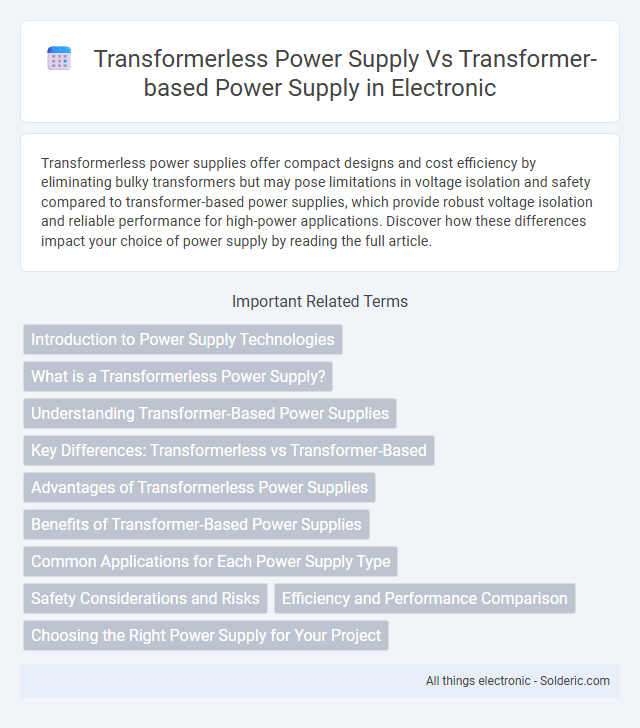Transformerless power supplies offer compact designs and cost efficiency by eliminating bulky transformers but may pose limitations in voltage isolation and safety compared to transformer-based power supplies, which provide robust voltage isolation and reliable performance for high-power applications. Discover how these differences impact your choice of power supply by reading the full article.
Comparison Table
| Feature | Transformerless Power Supply | Transformer-Based Power Supply |
|---|---|---|
| Size & Weight | Compact and lightweight | Bulky and heavy |
| Cost | Lower cost | Higher cost |
| Voltage Isolation | No galvanic isolation | Provides galvanic isolation |
| Efficiency | Moderate efficiency | Higher efficiency |
| Output Voltage Stability | Less stable, sensitive to input variations | Stable, regulated output |
| Safety | Lower safety due to no isolation | Higher safety with isolation |
| Application | Low-power, cost-sensitive devices | High-power, safety-critical devices |
| Heat Dissipation | Higher heat generation | Lower heat generation |
Introduction to Power Supply Technologies
Transformerless power supplies utilize capacitive or resistive components to step down voltage, resulting in compact and cost-effective designs without bulky transformers. Transformer-based power supplies rely on electromagnetic induction to provide galvanic isolation and voltage conversion, ensuring safety and stability in high-power applications. Your choice between these technologies depends on factors like isolation requirements, power rating, and efficiency demands.
What is a Transformerless Power Supply?
A transformerless power supply is an electrical circuit that converts AC voltage to a lower DC voltage without using a bulky transformer, relying instead on components like capacitors, resistors, and diodes for voltage regulation and isolation. It is commonly used in low-power applications where size, cost, and weight are critical factors, but it offers limited isolation and safety compared to transformer-based designs. When choosing between transformerless and transformer-based power supplies, your application's voltage, current requirements, and safety standards must be carefully evaluated.
Understanding Transformer-Based Power Supplies
Transformer-based power supplies use magnetic cores and windings to efficiently step voltage levels up or down, providing isolation between input and output for enhanced safety. These power supplies offer stable voltage regulation and are widely used in applications requiring reliable and safe electrical energy conversion. Your choice of transformer-based power supply ensures consistent performance and protection from electrical surges in sensitive electronic devices.
Key Differences: Transformerless vs Transformer-Based
Transformerless power supplies rely on capacitive or resistive components for voltage reduction, resulting in a compact design with lower cost and weight but limited isolation and safety. Transformer-based power supplies provide galvanic isolation between input and output, ensuring higher safety and stable voltage regulation suitable for sensitive electronics. Your choice hinges on balancing safety, size, cost, and application requirements.
Advantages of Transformerless Power Supplies
Transformerless power supplies offer significant advantages including reduced size and weight, leading to more compact and lightweight electronic devices. They provide higher efficiency and lower cost due to the elimination of bulky transformers and simpler circuit design. Your electronics benefit from rapid response times and improved reliability in applications where isolation is not a critical concern.
Benefits of Transformer-Based Power Supplies
Transformer-based power supplies provide reliable voltage isolation, enhancing safety by preventing direct contact with high-voltage circuits. These power supplies efficiently handle high power levels and offer better voltage regulation under varying load conditions. Your choice of a transformer-based unit ensures consistent performance and reduced electromagnetic interference, ideal for sensitive electronic devices.
Common Applications for Each Power Supply Type
Transformerless power supplies are commonly used in low-power applications such as LED lighting, small household appliances, and battery chargers where compact size and cost-efficiency are critical. Transformer-based power supplies find widespread use in industrial equipment, medical devices, and consumer electronics requiring electrical isolation and stable voltage regulation. The choice depends on factors like isolation needs, power level, and safety standards compliance.
Safety Considerations and Risks
Transformerless power supplies pose higher safety risks due to their direct connection to the mains voltage, increasing shock hazards and requiring careful insulation and protective measures. Transformer-based power supplies offer galvanic isolation, significantly enhancing user safety by preventing direct electrical contact with high-voltage circuits. To protect Your devices and personal safety, choosing transformer-based designs is recommended when isolation and reduced electrical risk are critical.
Efficiency and Performance Comparison
Transformerless power supplies offer higher efficiency by eliminating bulky transformers, resulting in reduced energy losses and lighter, more compact designs ideal for space-constrained applications. Transformer-based power supplies provide better isolation and voltage regulation, enhancing performance in environments requiring stable and safe power delivery. Your choice depends on balancing efficiency needs with the importance of electrical isolation and performance reliability in your specific application.
Choosing the Right Power Supply for Your Project
Selecting the right power supply for your project depends on voltage requirements, size constraints, and safety considerations. Transformerless power supplies offer compact designs and cost efficiency but lack isolation, making them suitable for low-power, non-isolated applications. Transformer-based power supplies provide robust isolation, stable voltage regulation, and higher power handling, making them ideal for sensitive electronics and industrial projects requiring reliable performance.
transformerless power supply vs transformer-based power supply Infographic

 solderic.com
solderic.com